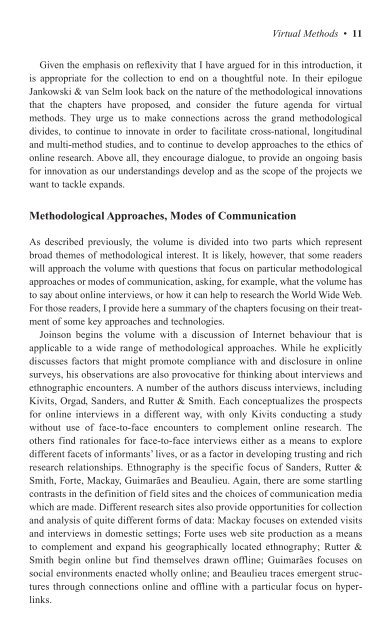Virtual Methods
Virtual Methods
Virtual Methods
Create successful ePaper yourself
Turn your PDF publications into a flip-book with our unique Google optimized e-Paper software.
Given the emphasis on reflexivity that I have argued for in this introduction, it<br />
is appropriate for the collection to end on a thoughtful note. In their epilogue<br />
Jankowski & van Selm look back on the nature of the methodological innovations<br />
that the chapters have proposed, and consider the future agenda for virtual<br />
methods. They urge us to make connections across the grand methodological<br />
divides, to continue to innovate in order to facilitate cross-national, longitudinal<br />
and multi-method studies, and to continue to develop approaches to the ethics of<br />
online research. Above all, they encourage dialogue, to provide an ongoing basis<br />
for innovation as our understandings develop and as the scope of the projects we<br />
want to tackle expands.<br />
Methodological Approaches, Modes of Communication<br />
<strong>Virtual</strong> <strong>Methods</strong> • 11<br />
As described previously, the volume is divided into two parts which represent<br />
broad themes of methodological interest. It is likely, however, that some readers<br />
will approach the volume with questions that focus on particular methodological<br />
approaches or modes of communication, asking, for example, what the volume has<br />
to say about online interviews, or how it can help to research the World Wide Web.<br />
For those readers, I provide here a summary of the chapters focusing on their treatment<br />
of some key approaches and technologies.<br />
Joinson begins the volume with a discussion of Internet behaviour that is<br />
applicable to a wide range of methodological approaches. While he explicitly<br />
discusses factors that might promote compliance with and disclosure in online<br />
surveys, his observations are also provocative for thinking about interviews and<br />
ethnographic encounters. A number of the authors discuss interviews, including<br />
Kivits, Orgad, Sanders, and Rutter & Smith. Each conceptualizes the prospects<br />
for online interviews in a different way, with only Kivits conducting a study<br />
without use of face-to-face encounters to complement online research. The<br />
others find rationales for face-to-face interviews either as a means to explore<br />
different facets of informants’ lives, or as a factor in developing trusting and rich<br />
research relationships. Ethnography is the specific focus of Sanders, Rutter &<br />
Smith, Forte, Mackay, Guimarães and Beaulieu. Again, there are some startling<br />
contrasts in the definition of field sites and the choices of communication media<br />
which are made. Different research sites also provide opportunities for collection<br />
and analysis of quite different forms of data: Mackay focuses on extended visits<br />
and interviews in domestic settings; Forte uses web site production as a means<br />
to complement and expand his geographically located ethnography; Rutter &<br />
Smith begin online but find themselves drawn offline; Guimarães focuses on<br />
social environments enacted wholly online; and Beaulieu traces emergent structures<br />
through connections online and offline with a particular focus on hyperlinks.



